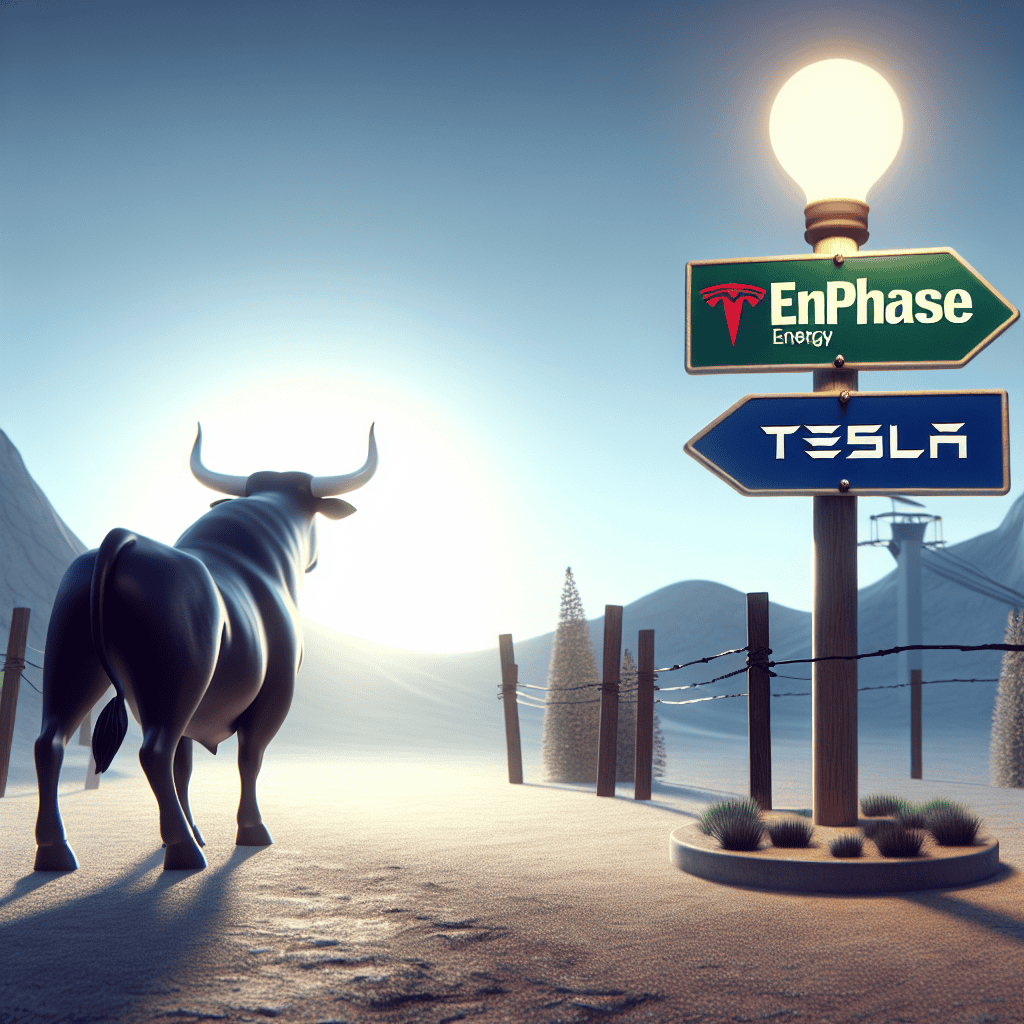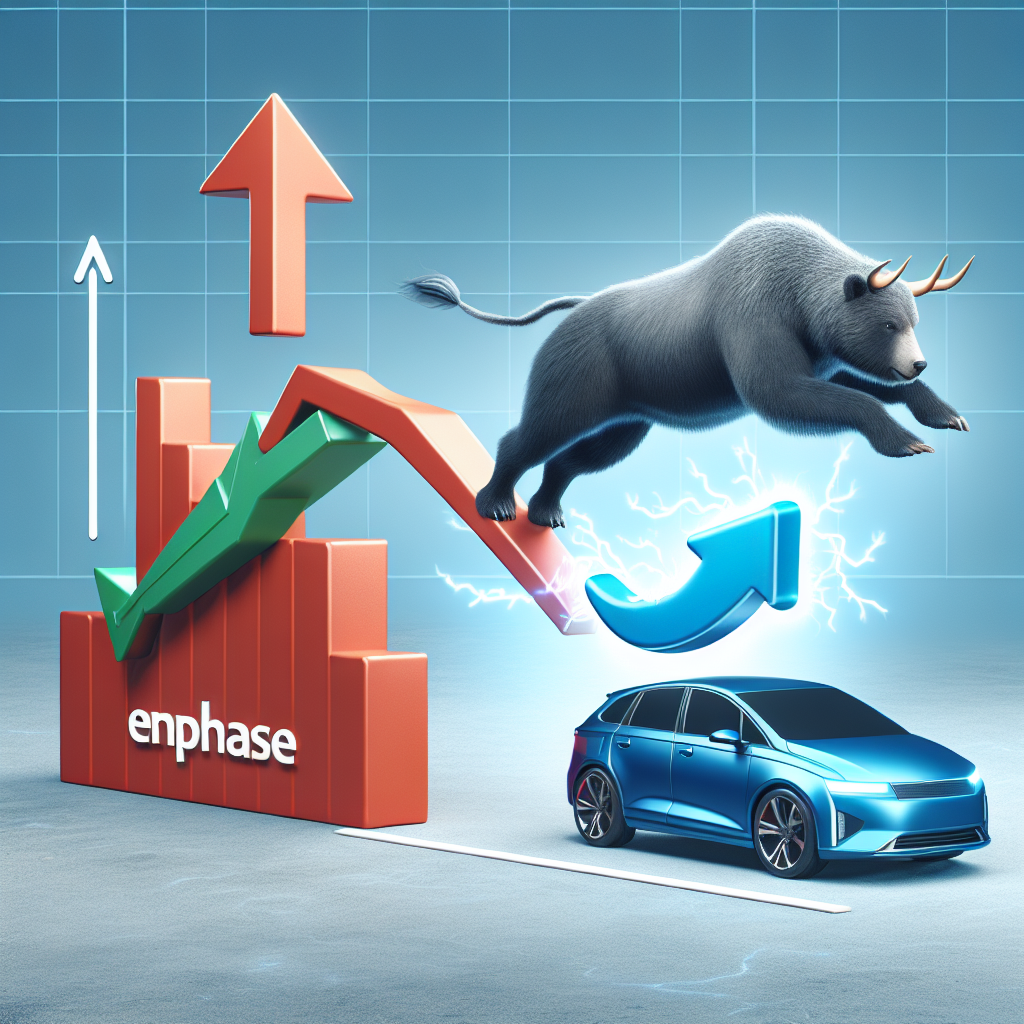“Enphase Energy Dims as Tesla Shines Brighter in the Solar Market.”
Introduction
Enphase Energy, a prominent player in the solar energy sector, recently experienced a setback as a bullish investor withdrew their support, a move that has been partially attributed to competitive pressures from Tesla. As a leader in microinverter technology, Enphase has been at the forefront of advancing solar energy solutions, but the evolving landscape of renewable energy, marked by Tesla’s aggressive expansion and innovation in solar products and energy storage, has introduced new challenges. This shift in investor sentiment highlights the dynamic and competitive nature of the renewable energy market, where companies like Enphase must continuously adapt to maintain their edge against formidable competitors like Tesla.
Impact Of Tesla’s Market Moves On Enphase Energy
Enphase Energy, a prominent player in the solar energy sector, has recently experienced a shift in investor sentiment, partly due to strategic moves by Tesla. As the renewable energy landscape evolves, companies like Enphase and Tesla are at the forefront, driving innovation and competition. However, Tesla’s recent market maneuvers have had a notable impact on Enphase Energy, leading to a reassessment by some investors who previously held bullish views on the company.
To understand the dynamics at play, it is essential to consider the broader context of the renewable energy market. Enphase Energy has built a strong reputation for its microinverter technology, which optimizes the performance of solar panels by converting direct current (DC) to alternating current (AC) at the individual panel level. This technology has been instrumental in enhancing the efficiency and reliability of solar energy systems, making Enphase a favored choice among consumers and installers alike.
However, Tesla’s aggressive expansion into the solar energy market has introduced new challenges for Enphase. Tesla’s Solar Roof and Powerwall products have gained significant attention, offering integrated solutions that combine solar generation with energy storage. This holistic approach appeals to consumers seeking seamless and efficient energy solutions, potentially drawing market share away from companies like Enphase that focus primarily on specific components of the solar ecosystem.
Moreover, Tesla’s brand recognition and extensive resources provide it with a competitive edge. The company’s ability to leverage its existing infrastructure, such as its Gigafactories and established distribution networks, allows it to scale operations rapidly and reduce costs. This capability poses a direct challenge to Enphase, which must navigate the complexities of scaling its operations while maintaining its technological edge.
In addition to these competitive pressures, Tesla’s influence extends to investor perceptions. The company’s charismatic CEO, Elon Musk, has a track record of capturing public and investor attention, often resulting in significant market movements. As Tesla continues to make headlines with its ambitious projects and innovations, investor enthusiasm can shift, impacting the stock performance of other companies in the sector, including Enphase.
Furthermore, Tesla’s strategic partnerships and collaborations have the potential to reshape the competitive landscape. By aligning with other industry leaders and exploring new business models, Tesla can create synergies that enhance its market position. This dynamic environment necessitates that Enphase continuously innovates and adapts to maintain its relevance and appeal to investors.
Despite these challenges, it is important to recognize that Enphase Energy remains a formidable player in the solar industry. The company’s commitment to research and development, coupled with its focus on customer satisfaction, positions it well to navigate the evolving market. Additionally, the growing global emphasis on renewable energy and sustainability provides a favorable backdrop for Enphase to capitalize on emerging opportunities.
In conclusion, while Tesla’s market moves have undoubtedly influenced investor sentiment towards Enphase Energy, the latter’s strong foundation and innovative spirit offer reasons for optimism. As the renewable energy sector continues to evolve, both companies are likely to play pivotal roles in shaping the future of clean energy. Investors and industry observers will be keenly watching how Enphase Energy responds to the challenges and opportunities presented by Tesla’s strategic maneuvers, as well as the broader trends in the renewable energy market.
Analyzing The Shift In Investor Sentiment Towards Enphase
In recent months, investor sentiment towards Enphase Energy has experienced a noticeable shift, with several factors contributing to this change. One of the most significant influences on this sentiment is the competitive landscape in the renewable energy sector, particularly the role of Tesla. As a major player in the energy market, Tesla’s advancements and strategic moves have inevitably impacted perceptions of other companies, including Enphase Energy.
To understand this shift, it is essential to consider the broader context of the renewable energy industry. The sector has been characterized by rapid technological advancements and increasing competition, as companies strive to innovate and capture market share. Enphase Energy, known for its microinverter technology, has been a prominent figure in this space, consistently delivering strong financial performance and technological innovation. However, the competitive dynamics are evolving, and Tesla’s growing presence in the energy market is a critical factor in this transformation.
Tesla’s energy division, which includes solar products and energy storage solutions, has been gaining traction. The company’s ability to leverage its brand recognition and technological prowess has allowed it to make significant inroads into the renewable energy market. Tesla’s integrated approach, combining solar panels with battery storage solutions like the Powerwall, offers a compelling value proposition to consumers. This holistic energy solution not only enhances energy efficiency but also provides a seamless user experience, which is increasingly appealing to environmentally conscious consumers.
As Tesla continues to expand its energy offerings, investors are taking note of the potential implications for other companies in the sector. Enphase Energy, despite its strong market position, faces the challenge of differentiating itself in an environment where Tesla’s influence is growing. The perception of increased competition from a company with Tesla’s resources and brand equity can lead to a reevaluation of Enphase’s growth prospects, affecting investor sentiment.
Moreover, Tesla’s strategic initiatives, such as its focus on vertical integration and its commitment to reducing costs, further intensify the competitive pressure. By controlling more aspects of the supply chain, Tesla can potentially offer more competitive pricing, which could impact the market dynamics for companies like Enphase. Investors, always keen to anticipate shifts in market trends, may view these developments as a signal to reassess their positions in Enphase Energy.
In addition to competitive pressures, macroeconomic factors also play a role in shaping investor sentiment. The renewable energy sector is influenced by policy changes, regulatory developments, and economic conditions, all of which can affect company valuations. For instance, fluctuations in government incentives for solar energy or changes in trade policies can have significant implications for companies operating in this space. Investors must navigate these complexities, balancing the potential risks and rewards associated with their investments.
In conclusion, the shift in investor sentiment towards Enphase Energy is a multifaceted issue, influenced by both competitive dynamics and broader economic factors. Tesla’s growing presence in the renewable energy market is a key element in this evolving landscape, prompting investors to reconsider their outlook on Enphase. As the industry continues to evolve, companies like Enphase must adapt to maintain their competitive edge and reassure investors of their long-term growth potential. This dynamic environment underscores the importance of strategic agility and innovation in the renewable energy sector, as companies strive to meet the demands of an ever-changing market.
Tesla’s Role In The Changing Dynamics Of The Solar Industry
In recent years, the solar industry has witnessed significant shifts, with major players like Enphase Energy experiencing fluctuations in their market positions. A notable factor contributing to these changes is the evolving role of Tesla, a company traditionally known for its electric vehicles but increasingly influential in the renewable energy sector. Tesla’s strategic maneuvers and technological advancements have begun to reshape the competitive landscape, impacting companies like Enphase Energy in unexpected ways.
Tesla’s entry into the solar market was marked by its acquisition of SolarCity in 2016, a move that signaled its commitment to becoming a major player in the renewable energy space. Since then, Tesla has focused on integrating solar energy solutions with its existing product lines, such as the Powerwall, a home battery system designed to store solar energy for later use. This integration has allowed Tesla to offer a comprehensive energy solution that appeals to environmentally conscious consumers seeking to reduce their reliance on traditional energy sources.
Moreover, Tesla’s brand recognition and innovative approach have given it a competitive edge, enabling it to capture a significant share of the solar market. The company’s ability to leverage its existing customer base and cross-promote its solar products with its electric vehicles has further strengthened its position. As a result, Tesla has become a formidable competitor to established solar companies like Enphase Energy, which specializes in microinverter technology that optimizes the performance of solar panels.
The impact of Tesla’s growing influence is evident in the shifting dynamics of the solar industry. Enphase Energy, once a darling of investors, has seen its stock performance affected by Tesla’s aggressive expansion and competitive pricing strategies. Investors who were once bullish on Enphase are now reevaluating their positions, considering Tesla’s potential to disrupt the market further. This shift in investor sentiment underscores the broader trend of consolidation and competition within the renewable energy sector.
Furthermore, Tesla’s focus on innovation and cost reduction has put pressure on other solar companies to adapt and evolve. The company’s commitment to reducing the cost of solar installations through advancements in technology and economies of scale has set a new benchmark for the industry. As a result, companies like Enphase Energy are compelled to innovate continuously to maintain their competitive edge and meet the growing demand for affordable and efficient solar solutions.
In addition to technological advancements, Tesla’s influence extends to policy and regulatory aspects of the solar industry. The company’s high-profile advocacy for renewable energy policies and its involvement in shaping industry standards have positioned it as a key player in the broader energy transition. This influence has implications for all solar companies, including Enphase Energy, as they navigate an increasingly complex regulatory environment.
In conclusion, Tesla’s role in the changing dynamics of the solar industry cannot be overstated. Its strategic initiatives, technological innovations, and market influence have created a ripple effect that is reshaping the competitive landscape. For companies like Enphase Energy, adapting to these changes is crucial to maintaining their market position and capitalizing on the growing demand for renewable energy solutions. As the solar industry continues to evolve, the interplay between established players and emerging disruptors like Tesla will undoubtedly shape its future trajectory.
Enphase Energy’s Market Challenges Amid Tesla’s Growth

Enphase Energy, a prominent player in the solar energy sector, has recently faced significant market challenges, partly due to the growing influence of Tesla in the renewable energy landscape. As the demand for sustainable energy solutions continues to rise, companies like Enphase and Tesla are at the forefront of innovation, striving to capture a larger share of the market. However, the competitive dynamics between these two companies have shifted, with Tesla’s advancements posing a formidable challenge to Enphase’s market position.
To understand the current situation, it is essential to consider the broader context of the renewable energy industry. The global push towards clean energy has accelerated the adoption of solar power systems, creating a lucrative market for companies that can offer efficient and reliable solutions. Enphase Energy, known for its microinverter technology, has been a key player in this space, providing products that enhance the performance and reliability of solar installations. However, as the industry evolves, so too do the strategies and technologies employed by its participants.
Tesla, a company synonymous with innovation, has made significant strides in the renewable energy sector, particularly with its solar and energy storage solutions. The company’s integrated approach, combining solar panels with its Powerwall battery systems, offers consumers a comprehensive energy solution that is both efficient and user-friendly. This holistic offering has resonated with consumers, leading to increased adoption and, consequently, a more competitive market environment for companies like Enphase.
Moreover, Tesla’s brand recognition and market reach provide it with a distinct advantage. The company’s ability to leverage its existing customer base and cross-promote its energy products with its electric vehicles has created a synergistic effect, further solidifying its position in the market. This has put pressure on Enphase to differentiate its offerings and maintain its competitive edge.
In response to these challenges, Enphase Energy has been focusing on innovation and strategic partnerships to bolster its market position. The company has been investing in research and development to enhance its product offerings, aiming to provide superior performance and reliability. Additionally, Enphase has been exploring collaborations with other industry players to expand its reach and tap into new markets. These efforts are crucial for the company to navigate the increasingly competitive landscape and sustain its growth trajectory.
However, the road ahead is not without obstacles. The renewable energy sector is characterized by rapid technological advancements and shifting consumer preferences, necessitating continuous adaptation and agility. Enphase must not only contend with Tesla’s growing influence but also anticipate and respond to emerging trends and disruptions in the industry.
In conclusion, Enphase Energy’s market challenges are emblematic of the broader competitive dynamics within the renewable energy sector. As Tesla continues to expand its footprint and innovate, companies like Enphase must strategically position themselves to remain relevant and competitive. By focusing on innovation, strategic partnerships, and market differentiation, Enphase can navigate these challenges and continue to play a vital role in the transition to a sustainable energy future. The interplay between these industry giants underscores the dynamic nature of the renewable energy market and the ongoing quest for leadership in this critical sector.
The Competitive Landscape: Enphase Vs. Tesla
In the rapidly evolving landscape of renewable energy, competition is fierce, and companies are constantly vying for dominance. Enphase Energy, a prominent player in the solar energy sector, has recently faced a setback as it lost a bullish investor. This development is intricately linked to the competitive dynamics between Enphase and Tesla, another major contender in the renewable energy market. Understanding the nuances of this rivalry provides insight into the broader trends shaping the industry.
Enphase Energy has long been recognized for its innovative microinverter technology, which optimizes the efficiency of solar panels by converting direct current (DC) to alternating current (AC) at the individual panel level. This technology has positioned Enphase as a leader in the residential solar market, offering solutions that enhance energy production and reliability. However, the competitive landscape is shifting, and Tesla’s entry into the solar energy sector has introduced new challenges for Enphase.
Tesla, a company synonymous with innovation, has expanded its focus beyond electric vehicles to include solar energy solutions. With its acquisition of SolarCity in 2016, Tesla has been working to integrate solar power with its energy storage products, such as the Powerwall. This integration offers consumers a comprehensive energy solution that combines solar generation with battery storage, providing a seamless and efficient way to harness and utilize renewable energy. As a result, Tesla has become a formidable competitor in the solar market, appealing to consumers who value the convenience of an all-in-one energy system.
The competition between Enphase and Tesla is not merely a battle of technologies but also a contest of brand influence and market strategy. Tesla’s strong brand recognition and its ability to leverage its existing customer base have given it a significant advantage. Moreover, Tesla’s direct-to-consumer sales model allows it to control the customer experience more effectively, potentially attracting consumers who prioritize brand loyalty and integrated solutions.
In contrast, Enphase has traditionally relied on partnerships with solar installers and distributors to reach its customers. While this approach has allowed Enphase to focus on its core competency of developing cutting-edge technology, it also means that the company is more dependent on third parties for customer acquisition and service delivery. This dependency can be a disadvantage in a market where direct engagement with consumers is increasingly important.
Furthermore, the competitive pressure from Tesla has implications for investor sentiment. The loss of a bullish investor for Enphase may reflect concerns about the company’s ability to maintain its market position in the face of Tesla’s aggressive expansion. Investors are keenly aware of the importance of innovation and market adaptability, and any perceived vulnerability can influence investment decisions.
Despite these challenges, it is important to recognize that the renewable energy market is vast and growing. Both Enphase and Tesla have significant opportunities to capture market share as the demand for clean energy solutions continues to rise. The competition between these two companies is likely to drive further innovation and improvements in solar technology, ultimately benefiting consumers and advancing the transition to sustainable energy.
In conclusion, the competitive landscape between Enphase Energy and Tesla is a microcosm of the broader dynamics at play in the renewable energy sector. As these companies navigate the challenges and opportunities of this rapidly changing market, their strategies and innovations will shape the future of solar energy. The rivalry underscores the importance of adaptability, brand strength, and technological advancement in an industry that is crucial to addressing global energy needs.
How Tesla’s Innovations Affect Enphase Energy’s Stock Performance
Enphase Energy, a prominent player in the solar energy sector, has recently experienced a shift in its stock performance, and Tesla’s innovations appear to be a significant factor in this development. As the renewable energy landscape evolves, companies like Enphase must navigate a complex environment where technological advancements and market dynamics play crucial roles. Tesla, known for its groundbreaking innovations in electric vehicles and energy storage, has increasingly become a formidable competitor in the solar energy market. This competition has implications for Enphase Energy, influencing investor sentiment and, consequently, its stock performance.
Tesla’s entry into the solar energy market has been marked by its commitment to integrating solar technology with its existing product lines, such as electric vehicles and energy storage solutions. The company’s Solar Roof and Powerwall products exemplify this strategy, offering consumers a seamless energy ecosystem that combines solar generation with storage and electric vehicle charging. This holistic approach appeals to environmentally conscious consumers seeking comprehensive solutions, thereby enhancing Tesla’s competitive edge. As a result, companies like Enphase, which specialize in microinverter technology for solar panels, face increased pressure to differentiate themselves and maintain their market share.
Moreover, Tesla’s brand recognition and marketing prowess further amplify its influence in the renewable energy sector. The company’s ability to capture public attention and generate excitement around its products often translates into increased consumer interest and investor confidence. This dynamic can create challenges for competitors like Enphase, which may struggle to match Tesla’s visibility and market reach. Consequently, investors may perceive Enphase as a less attractive option, leading to fluctuations in its stock performance.
In addition to Tesla’s market presence, its continuous innovation in energy technology poses another challenge for Enphase. Tesla’s focus on research and development has resulted in advancements that push the boundaries of what is possible in renewable energy. For instance, improvements in battery technology and energy efficiency not only enhance Tesla’s product offerings but also set new industry standards. Enphase must keep pace with these innovations to remain competitive, necessitating significant investment in research and development. This requirement can strain resources and impact profitability, further influencing investor perceptions and stock performance.
Furthermore, Tesla’s strategic partnerships and acquisitions have bolstered its position in the renewable energy market. By aligning with other industry leaders and acquiring companies with complementary technologies, Tesla has expanded its capabilities and market reach. These strategic moves enable Tesla to offer more comprehensive solutions, thereby attracting a broader customer base. For Enphase, this means facing a competitor with an increasingly diversified portfolio, which can make it more challenging to capture and retain market share.
Despite these challenges, it is important to note that Enphase Energy remains a key player in the solar energy sector, with its own strengths and innovations. The company’s focus on microinverter technology provides unique advantages, such as improved energy efficiency and system reliability. However, the influence of Tesla’s innovations on Enphase’s stock performance underscores the need for strategic adaptation and differentiation in a rapidly evolving market. As the renewable energy landscape continues to change, Enphase must navigate these dynamics carefully to sustain its growth and maintain investor confidence. In conclusion, while Tesla’s innovations present challenges for Enphase Energy, they also highlight the importance of innovation and strategic agility in the renewable energy sector.
Strategic Responses For Enphase Energy In A Tesla-Dominated Market
In the rapidly evolving landscape of renewable energy, Enphase Energy has long been recognized as a formidable player, particularly in the realm of solar microinverters. However, recent developments have seen a shift in investor sentiment, with some analysts downgrading their outlook on the company. A significant factor contributing to this change is the growing influence of Tesla in the energy sector. As Tesla continues to expand its footprint, Enphase Energy faces the challenge of strategically positioning itself in a market increasingly dominated by the electric vehicle giant.
Tesla’s aggressive push into solar energy and energy storage solutions has undoubtedly intensified competition. The company’s integrated approach, combining solar panels, energy storage, and electric vehicles, offers consumers a comprehensive energy ecosystem. This holistic strategy not only appeals to environmentally conscious consumers but also leverages Tesla’s brand strength and technological innovation. Consequently, Enphase Energy must navigate this competitive landscape by identifying and capitalizing on its unique strengths.
One potential strategic response for Enphase Energy is to focus on technological differentiation. While Tesla’s brand and integrated solutions are formidable, Enphase has a strong reputation for its advanced microinverter technology. By continuing to innovate and improve the efficiency and reliability of its products, Enphase can maintain a competitive edge. Investing in research and development to enhance product offerings could attract customers who prioritize cutting-edge technology and performance.
Moreover, Enphase Energy could explore strategic partnerships and collaborations to bolster its market position. By aligning with other companies in the renewable energy sector, Enphase can expand its reach and offer more comprehensive solutions. Collaborations with battery storage companies, for instance, could enable Enphase to provide integrated energy solutions that rival Tesla’s offerings. Such partnerships could also facilitate entry into new markets and customer segments, thereby diversifying revenue streams.
In addition to technological innovation and partnerships, Enphase Energy might consider enhancing its customer engagement and service offerings. Providing exceptional customer service and support can differentiate Enphase from competitors and foster customer loyalty. By investing in customer education and support, Enphase can empower consumers to make informed decisions about their energy needs. This approach not only builds trust but also positions Enphase as a customer-centric company in an industry where consumer awareness and education are crucial.
Furthermore, Enphase Energy could leverage its global presence to tap into emerging markets where Tesla’s influence may be less pronounced. By identifying regions with high solar potential and less competition, Enphase can establish a strong foothold and drive growth. Tailoring products and services to meet the specific needs of these markets can also enhance Enphase’s competitive advantage.
While the rise of Tesla presents challenges, it also underscores the growing demand for renewable energy solutions. Enphase Energy can view this as an opportunity to refine its strategies and reinforce its position in the market. By focusing on technological innovation, strategic partnerships, customer engagement, and global expansion, Enphase can navigate the competitive landscape and continue to thrive.
In conclusion, the evolving dynamics of the renewable energy sector necessitate strategic responses from companies like Enphase Energy. As Tesla’s influence grows, Enphase must leverage its strengths and adapt to changing market conditions. Through innovation, collaboration, and customer-centric approaches, Enphase can not only withstand the competitive pressures but also seize new opportunities for growth and success in a Tesla-dominated market.
Q&A
1. **What is the main reason for Enphase Energy losing a bull?**
Enphase Energy lost a bull due to increased competition and market pressure from Tesla’s advancements in solar energy and battery storage solutions.
2. **How has Tesla impacted Enphase Energy’s market position?**
Tesla’s innovations and competitive pricing in solar technology and energy storage have challenged Enphase Energy’s market share and growth prospects.
3. **What specific Tesla products are affecting Enphase Energy?**
Tesla’s solar panels and Powerwall battery systems are directly competing with Enphase Energy’s microinverters and energy management solutions.
4. **How have investors reacted to the competition between Enphase and Tesla?**
Investors have shown concern over Enphase Energy’s ability to maintain its competitive edge, leading to a downgrade by some analysts.
5. **What are analysts saying about Enphase Energy’s future prospects?**
Analysts are cautious about Enphase Energy’s future growth, citing increased competition and the need for innovation to stay competitive.
6. **Has Enphase Energy taken any steps to counter Tesla’s influence?**
Enphase Energy is focusing on expanding its product offerings and improving its technology to better compete with Tesla.
7. **What is the overall market sentiment towards Enphase Energy amid Tesla’s competition?**
The market sentiment is mixed, with some investors optimistic about Enphase’s potential to innovate, while others are wary of Tesla’s growing influence in the sector.
Conclusion
Enphase Energy’s recent loss of a bullish outlook can be attributed to increased competition from Tesla in the solar energy market. Tesla’s advancements and strategic moves in solar technology and energy storage solutions have intensified the competitive landscape, potentially impacting Enphase’s market share and growth prospects. This shift highlights the dynamic nature of the renewable energy sector, where innovation and strategic positioning are crucial for maintaining a competitive edge.





